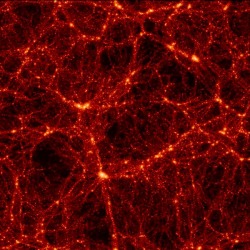Chivalloot™© By Ramsey Ronalds
100% FUN 100% FREE
100% FUN 100% FREE
Dark Matter
When the universe was young, it was almost smooth and had very little features. As it grew and grew older the universe began to get "organized." For example, our Solar System is organized by planets orbiting our sun. Out of this, these stars organize themselves into large clusters, we call these GALAXIES. Our sun is an average star among about 100 billion other stars that have all organized themselves to form what we call the Milkyway. Further more, astronomers call galaxies grouped together clusters of galaxies.
This includes the galaxies clustered together and any material which lies between the spaces of these galaxies. The force or glue that holds these galaxies together is gravity. The space between clusters of galaxies is a very hot gas at about tens of millions of degrees. By studying the distribution and temperature of the hot gas we can measure how much it is being squeezed by the force of gravity on all the material in the cluster. This allows scientists to determine how much total material (matter) there is in that part of space.
It turns out that their is five times more material in clusters of galaxies that we would expect from the hot gas. Most of the stuff in clusters of galaxies is invisible and, since these are the largest structures in the Universe held together by gravity, scientists then conclude that most of the matter in the entire Universe is invisible. This invisible stuff is called 'dark matter.' There is currently much ongoing research by scientists attempting to discover exactly what this dark matter is, how much there is, and what effect it may have on the future of the Universe as a whole.
This includes the galaxies clustered together and any material which lies between the spaces of these galaxies. The force or glue that holds these galaxies together is gravity. The space between clusters of galaxies is a very hot gas at about tens of millions of degrees. By studying the distribution and temperature of the hot gas we can measure how much it is being squeezed by the force of gravity on all the material in the cluster. This allows scientists to determine how much total material (matter) there is in that part of space.
It turns out that their is five times more material in clusters of galaxies that we would expect from the hot gas. Most of the stuff in clusters of galaxies is invisible and, since these are the largest structures in the Universe held together by gravity, scientists then conclude that most of the matter in the entire Universe is invisible. This invisible stuff is called 'dark matter.' There is currently much ongoing research by scientists attempting to discover exactly what this dark matter is, how much there is, and what effect it may have on the future of the Universe as a whole.

LEFT: A simulated image of dark matter.
